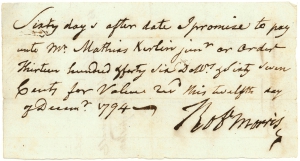Robert Morris Promissory Note,
Used As Evidence In His Bankruptcy Trial |
Click to enlarge:

Select an image:
Financier of the Revolution forced into bankruptcy court: “Sixty days after date, I promise to pay unto Mr. Mathias Kurlin Junr or Order Thirteen Hundred & forty six Dolls & Sixty Seven Cents for value recd.”
ROBERT MORRIS.
Autograph Document Signed, December 12, 1794. 1 p., 7⅛ x 3¾ in.
Inventory #20892
SOLD — please inquire about other items
On the document’s verso is a note reading “Exhibited to us under the commission against Robert Morris, Philadelphia, 15th October 1801.”
Signed by John Hollowell and Thomas Cumpston, commissioners appointed to oversee the bankruptcy proceedings after Morris had languished in debtor’s prison for three years.
Historical Background
Robert Morris (1734-1806), signer of the Declaration of Independence, merchant and land speculator, is best known for his role as financier for the Continental Congress. With the national government virtually bankrupt, Morris risked his own personal fortune by purchasing supplies for the army, pressuring the states for cash contributions and securing a major French loan to finance the Bank of North America. He spent his remaining years in various public positions, including senator of Pennsylvania. Morris speculated extensively in Western land after the war, forming the North American Land Co. with James Greenleaf and Jonathan Nicholson. Soon after, however, the land market collapsed and Morris was ruined. The final blow came in 1798, when a minor creditor’s claim sent him to the Philadelphia debtor’s prison. It has often been said that while George Washington was president, he felt he could not pardon his long-time friend, but visited Morris in debtor’s prison as a show of support. That story is only half true. Morris didn’t enter debtor’s prison until 1798, two years after Washington’s presidency, so Washington couldn’t have pardoned him, but he did visit Morris in prison, where the latter remained for three years until his wife was able to bail him out.
*This item is also being offered in part II of The Alexander Hamilton Collection